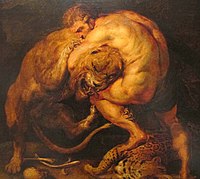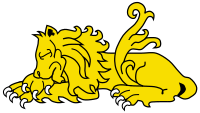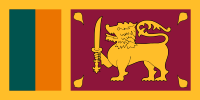Cultural depictions of lions

Lions, particularly male lions, have been an important symbol for thousands of years and appear as a theme in cultures across Europe, Asia, and Africa. Despite the recorded incidents of attacks on humans, lions enjoy positive depiction in popular culture as creatures that appear strong, but gentle at the same time. The most consistent depiction is in keeping with their image of "king of the jungle" or "king of the beasts", hence lions are popular symbols of royalty and stateliness and a symbol of bravery.
In religion and mythology
First depictions

The earliest recorded depictions of lions can be found in some of the earliest paleolithic human cave art possibly dating to 32,000 years ago in the Chauvet Cave in the Ardèche region of southern France, where lionesses are depicted hunting for the pride in much the same strategy as contemporary lions.[1] Some have proposed a more conservative estimate in line with the better known cave paintings of Lascaux, that are 15,000 years old.[2] In the Lascaux, two lions were depicted mating in the Chamber of Felines. The ivory carving from Vogelherd cave in the Swabian Jura in southwestern Germany has been determined to be about 32,000 years old from the Aurignacian culture.

Found first in Ancient Egypt the sphinx, which had the head and shoulders of a human and the body of a lioness, represented the goddess who was the protector of the pharaohs. Later pharaohs were depicted as sphinxes, being thought as the offspring of the deity. Bast (cat goddess of protection and the "eye of Ra") originally was depicted as a lioness.[3]
The war goddess Sekhmet typically was depicted as woman with a lioness head or, just as a lioness.[3] During the New Kingdom the Nubian gods Maahes (god of war and protection and the son of Bast) and Dedun (god of incense, hence luxury and wealth) were depicted as lions. Maahes was absorbed into the Egyptian pantheon, and had a temple at the city Leontopolis "City of Lions" in Lower Egypt attached to that of the temple of his mother. Dedun was not absorbed into the Egyptian religion and remained a Nubian deity. The Egyptians held that a sacred lioness was responsible for the annual flooding of the Nile.[3]
Lions were represented in other middle-eastern cultures. In ancient Mesopotamia it was regarded as a symbol of kingship.[4] The Dying Lioness is a relief panel from 650 BCE, Nineveh (modern day Iraq) depicting a half-paralyzed lioness pierced with arrows, while the Babylonian goddess Ishtar has been represented driving a chariot drawn by seven lions.[3] Ishtar's Sumerian analogue Inanna was frequently depicted standing on the backs of two lionesses. Such symbolism was appropriated by Saddam Hussein's regime in Iraq for their Lion of Babylon tank, with the technology adapted from a Russian model.[citation needed]
Ancient

Lions have been widely used in sculpture and statuary to provide a sense of majesty and awe, especially on public buildings.[5][6] This usage dates back to the origin of civilization.[7] There are lions at the entrances of cities and sacred sites from Mesopotamian cultures; notable examples include the Lion Gate of ancient Mycenae in Greece that has two lionesses flanking a column that represents a deity,[8] and the gates in the walls of the Hittite city of Bogazköy, Turkey.[6] The "Lion of Menecrates" is a funerary statue of a crouching lion, found near the cenotaph of Menecrates. The lion is Work of a famous Corinthian sculptor of the Archaic Greece, end of the 7th century BC, and is found at the Archaeological Museum of Corfu.
Persia

Lions have been extensively used in ancient Persia as sculptures and on the walls of palaces, in fire temples, tombs, on dishes and jewellery; especially during the Achaemenid Empire. The gates were adorned with lions.[9] Evidences are found in Persepolis, Susa, Hyrcania, etc.
Classical period
The most notable lion of Ancient Greek mythology was the Nemean lion, killed barehanded by Heracles, who subsequently bore the pelt as an invulnerable magic cloak.[10] This lion is also said to be represented by the constellation of Leo, and also the sign of the Zodiac.
Lions are known in many cultures as the king of animals, which can be traced to the classical book Physiologus. In his fables, the famed Greek story teller Aesop utilized the lion's symbolism of power and strength in The Lion and the Mouse and Lion's Share.
In Socrates' model of the psyche (as described by Plato), the bestial, selfish nature of humanity is described metaphorically as a lion, the "leontomorphic principle".[11]
Biblical references and Judaeo-Christian tradition

Several Biblical accounts document the presence of lions, and cultural perception of them in ancient Palestine. The best known Biblical account featuring lions comes from the Book of Daniel (chapter 6), where Daniel is thrown into a den of lions and miraculously survives.
A lesser known Biblical account features Samson who kills a lion with his bare hands, later sees bees nesting in its carcass, and poses a riddle based on this unusual incident to test the faithfulness of his fiancee (Judges 14).

The prophet Amos said (Amos, 3, 8): "The lion hath roared, who will not fear? the Lord GOD hath spoken, who can but prophesy?", i.e., when the gift of prophecy comes upon a person, he has no choice but to speak out.
In 1 Peter 5:8, the Devil is compared to a roaring lion "seeking someone to devour."[12][13]
In Christian tradition, Mark the Evangelist, the author of the second gospel is symbolized by a lion - a figure of courage and monarchy. It also represents Jesus' Resurrection (because lions were believed to sleep with open eyes, a comparison with Christ in the tomb), and Christ as king. Some Christian legends refer to Saint Mark as "Saint Mark the Lionhearted". These probably false legends say that he was fed to the lions and the animals refused to attack or eat him. Instead the lions slept at his feet, while he petted them. When the Romans saw this, they released him, spooked by the sight.
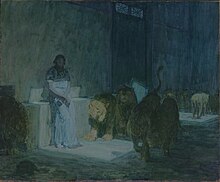
The lion is the biblical emblem of the tribe of Judah and later the Kingdom of Judah.[14] It is contained within Jacob's blessing to his fourth son in the penultimate chapter of the Book of Genesis, "Judah is a lion's whelp; On prey, my son have you grown. He crouches, lies down like a lion, like the king of beasts—who dare rouse him?" (Genesis 49:9[15]). In the modern state of Israel, the lion remains the symbol of the capital city of Jerusalem, emblazoned on both the flag and coat of arms of the city.[citation needed] Unlike Christianity, in Judaism, The lion has positive connotations. For instance, in every synagogue there is an ark with a depiction in which lions face each other like bookends with the torah in the middle, as if they were protecting it
Late antiquity mysticism
In gnostic traditions, the Demiurge is depicted as a lion-faced figure ("leontoeides"). The gnostic concept of the Demiurge is usually that of a malevolent, petty creator of the physical realm, a false deity responsible for human misery and the gross matter than traps the spiritual essence of the soul, and thus an "animal-like" nature. As a lion-headed figure, the Demiurge is associated with devouring flames,[16] destroying the souls of humans after they die, as well as with arrogance and callousness.[17]
A lion-faced figurine is usually associated with the Mithraic mysteries. Without any known parallel in classical, Egyptian or middle-eastern art,[18] what this figure is meant to represent is currently unknown. Some have interpreted it to be a representation of Ahriman,[19] of the aforementioned gnostic Demiurge,[20] or of some similar malevolent, tyrannical entity, but it has also been interpreted as some sort of time or season deity[21] or even a more positive symbol of enlightenment and spiritual transcendence.[22]
- Cultural depictions of lions
-
Samson and the lions, Saint Trophime Church Portal (12th century)
-
A lion at the side of King Alfonso IX of Leon, from the Tumbo A cartulary of the Cathedral of Santiago de Compostela
-
A Hyrcanian Achaemenid golden cup. Dated first half of first millennium. Excavated at Kalardasht in Mazandaran, Iran.
Arthurian legend
In a key scene of "Yvain, the Knight of the Lion" (Template:Lang-fr), a romance by Chrétien de Troyes, the hero is depicted as rescuing a lion from a serpent.
Subsequently, the lion proves to be a loyal companion and a symbol of knightly virtue, and helps Yvain complete his altruistic ventures. In the happy end, the lion comes to dwell with Yvain and his wife Laudine at their castle.
- Sculptures of lions
-
Lion door handle at Burg Hohenzollern
-
One of the four lions Trafalgar Square by Landseer at the base
-
The Lion Monument in Lucerne, Switzerland, commemorates the sacrifice of the Swiss Guards at the Tuileries in 1792.
Islamic traditions
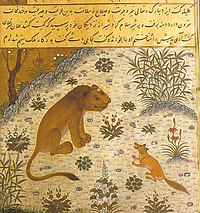
In Middle Eastern culture, both Arabic and Persian, lion regarded as the symbol of courage, bravery, royalty and chivalry. The Middle Eastern depiction of lion derived from earlier Mesopotamian Babylonian and Persian arts. Islamic art commonly manifests its aesthetic elements only in Islamic calligraphy, floral and geometric decorative patterns, since Islamic tradition forbid the depictions of humans and living creatures (animals) in its arts, both paintings or sculpture. However through Persian arts miniatures and paintings, the depictions of humans and animals survives. In Muslim Spain period, the lion court of Alhambra palace displays the lion statues as supporters and waterspout of fountain.
"Aslan" or "Arslan" (Ottoman ارسلان arslān and اصلان aṣlān) is the Turkish and Mongolian word for "lion". It was used as a title by a number of Seljuk and Ottoman rulers, including Alp Arslan and Ali Pasha, and is a Turkic/Iranian name.[citation needed]
Hindu-Buddhist traditions
The lion symbolism and its cultural depictions can be found in Hindu and Buddhist art of India and Southeast Asia. The lion symbolism in India was based upon Asiatic lions that once spread in Indian subcontinent as far as the Middle East.
India

Narasimha ("man-lion") (also spelt as Narasingh, Narasinga) is described as an incarnation (Avatara) of Vishnu within the Puranic texts of Hinduism and is worshiped as "Lion God" thus Indian or Asiatic lions which were commonly found throughout most of India in ancient times are considered sacred by all Hindus in India.
Lions can also be found in Buddhist symbolism. Emperor Ashoka of ancient India uses the emblem of chakra (dharmic wheel) and lion in his lion pillars erected in his realm in India. The Asiatic lions depicted in the Lion Capital of Ashoka have become the inspiration for the Emblem of India.
Singh is an ancient Indian vedic name meaning "lion" (Asiatic lion), dating back over 2000 years to ancient India. It was originally only used by Rajputs, a Hindu Kshatriya or military caste in India. After the birth of the Khalsa brotherhood in 1699, the Sikhs also adopted the name "Singh" due to the wishes of Guru Gobind Singh. Along with millions of Hindu Rajputs and numerous other Hindu martial groups today, it is also used by over 20 million Sikhs worldwide.[23][24] The appellation of the name Singh was used by the Rajputs before being adopted by the Sikhs in 1699.[25] Therefore, all "Singh"s in Indian history before 1699 are Hindu and mainly Rajputs; after 1699, Singhs from the Punjab are mostly Sikhs, while the Singhs from the Shivalik hill ranges of Punjab (also Kangra, Chamba, Simla) are mainly Rajputs. The lion also features as the carrier or the vehicle of Durga, the Hindu goddess of war, worshipped in and around the Bengal region.
The lion is symbolic for the Sinhalese, Sri Lanka's ethnic majority; the term derived from the Indo-Aryan Sinhala, meaning the "lion people" or "people with lion blood", while a sword-wielding lion is the central figure on the modern national flag of Sri Lanka.
The entrance to Sigiriya, the Lion-Rock of Sri Lanka, was through the Lion Gate, the mouth of a stone lion. The paws of the lion can still be seen today. It is one of seven World Heritage Sites in Sri Lanka.
Southeast Asia

Lions were never native animals of Southeast Asia in recorded history. As the result the depiction of lion in ancient Southeast Asian art, especially in ancient Java and Cambodia, is far from naturalistic style as depicted in Greek or Persian art counterparts, since the artist whom carved the lion sculpture never saw the actual lion before, and all based on perception and imagination. The cultural depictions and the reverence of lion as the noble and powerful beast in Southeast Asia was influenced by Indian culture especially through Buddhist symbolism.
Statue of a pair of lions often founds in temples in Southeast Asia as the gate guardian. In Borobudur Buddhist monument Central Java, Indonesia andesite stone statues of lions guarding four main entrances of Borobudur. The thrones of Buddha and Boddhisattva found in Kalasan and Mendut buddhist temples of ancient Java depicted elephant, lion, and makara. The statue of winged lion also found in Penataran temple East Java, as well as in Balinese temples. The Balinese winged lion often served as the guardian statue or as the pedestal of wooden column.
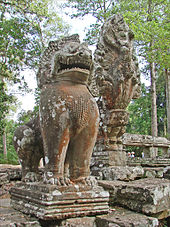
In Cambodia statue of lion flanking the temple gate or access roads are commonly found in temples of Angkor. Bakong, a stepped pyramid Hindu temple from earlier period also display lion statue as guardian of each stages on each cardinal points. Khmer lion guardian statues are commonly found in Angkor Wat, Bayon, Pre Rup and Srah Srang. Just like ancient Java, the depiction of lion in ancient Khmer art is not in naturalistic style, more like a symbolic mythical animal derived from Indian Hindu-Buddhist art. The royal emblem of Cambodia depicting a pair of guardian animals; gajasingha (hybrid of elephant and lion) and singha (lion). In Thailand, a pair of lion statues are often placed in front of temple gate as guardian. The style of Thai lion is similar to those of Cambodian, since Thailand derived many of its aesthetics and arts elements from Cambodian Khmer art.
In Myanmar, the statue of lion called Chinthe guarding the stupas, pagodas, and Buddhist temples in Bagan, while pair of lions are also featured in the country's coat-of-arms.
The island nation of Singapore (Singapura) derives its name from the Malay words [singa] Error: {{Lang}}: text has italic markup (help) (lion) and [pura] Error: {{Lang}}: text has italic markup (help) (city), which in turn is from the Tamil-Sanskrit சிங்க singa सिंह siṃha and पुर புர pura.[26] According to the Malay Annals, this name was given by a 14th-century Sumatran Malay prince named Sang Nila Utama, who, on alighting the island after a thunderstorm, spotted an auspicious beast on shore that his chief minister identified as a lion (Asiatic lion).[27] Recent studies of Singapore indicate that lions have never lived there, and the beast seen by Sang Nila Utama was likely a tiger.
In the modern era, the lion or Merlion became the icon of Singapore due to the island's name. The Merlion also figures heavily in the official symbols of the Philippines as it was once an overseas possession of Spain; it appears on the coat-of-arms of Manila, as well as the emblems of the President, Vice-President, and its navy.
Chinese and East Asian traditions

The common motif of the "majestic and powerful" lion was introduced to China by Buddhist missionaries from India, somewhere in the 1st century AD.[28] Lions themselves, however, are not native to China, yet appear in the art of China and the Chinese people believe that lions protect humans from evil spirits, hence the Chinese New Year lion dance to scare away demons and ghosts. Chinese guardian lions are frequently used in sculpture in traditional Chinese architecture. For instance, in the Forbidden City in Beijing, two lion statues are seen in almost every door entrance.
Lions feature prominently in the Tibetan culture with a pair of Snow Lions seen on the Tibetan flag. The Snow Lions are mythical creatures that are seen as protector entities. The Snow Lion symbolizes fearlessness, unconditional cheerfulness, east, and the Earth element. It is one of the Four Dignities. It ranges over the mountains, and is commonly pictured as being white with a turquoise mane.
Lions (獅子, shishi) feature prominently in many kabuki plays and other forms of Japanese legend and traditional tales.
Title of kings and political leaders
Various kings and political leaders in different cultures and times, famed for courage or fierceness, were titled "the lion" - such as
- Henry the Lion
- Richard the Lionheart
- Robert III, "The Lion of Flanders"
- Lala Lajpat Rai, "The Lion of Punjab".
- The Al-Assad family, ruling in Syria, derives its surname from the title Asad ("lion" in Arabic) of an ancestor.[29]
- Thirteen popes took the name Leo.
In fine art
Paintings
- Paintings of lions
-
Hieronymus and the lion, by Albrecht Altdorfer
-
The allegory of chastity by Hans Memling
-
Hercules fight with the Nemeean lion, Pieter Paul Rubens.
-
Löwe by German painter Albrecht Dürer, 1494.
Sculpture
This section needs expansion. You can help by adding to it. (April 2015) |
U.K.
- Nelson's Column (1843) in Trafalgar Square, London, UK, four lions sculpted by William Railton[30]
U.S.
- National Zoological Park, two 5,000 pound, reclining brass lions flank the Connecticut Avenue entrance[31]
- Patience and Fortitude, the two Tennessee marble lions flanking the main entrance to the Stephen A. Schwarzman Building, the New York Public Library main branch on Park Avenue, in Manhattan; sculpted by Edward Clark Potter
- Ulysses S. Grant Memorial, West Front, in the Botanic Garden, Washington D.C., four protective bronze lions crouching on the American flag, sculpted by Henry Merwin Shrady, installed April 28, 1912; shown in the opening credits of the House of Cards[30]
In heraldry
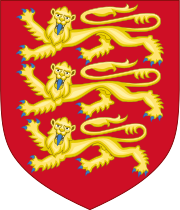
The lion is a common charge in heraldry, traditionally symbolizing courage.[32] The following positions of heraldic lions are recognized:[33]
|
|
|
The lion holds historical significance for English heraldry and symbolism. The three lions was a symbol for Richard the Lionheart, and later, for England. For many centuries the lion had been a feature of the Armorial of Plantagenet of the House of Plantagenet, and is still worn by both the England national football team and England and Wales cricket team.
The lion rampant continues to be used widely today; the Royal Standard of Scotland has given rise to its use as the emblem for the Scotland national football team and Rangers and Dundee United of the Scottish Premier League, as well as English Premier League club Aston Villa; and not only sport but businesses such as the French car company Peugeot, the international beer company Lion Nathan, and Caledonian MacBrayne ferries. Arising from heraldic use, the Red Lion is also a popular pub name, with over 600 pubs bearing the name.[34] A rarer inn name is the White Lion, derived from Edward VI or the Duke of Norfolk.[34] Though the lion rampant appears on the Lyon coat of arms and flag, the French city's name has an unrelated derivation despite the similarity. Rampant lions are common charges in heraldry. For example, the arms of the Carter of Castle Martin family, Ireland (see Carter-Campbell of Possil) include a pair of rampant combatant lions.
In the Middle Ages, when lions became a major element in heraldry, few Europeans had any chance to see actual lions. The lions were for them nearly as much legendary animals as were dragons or gryffins, which also commonly appeared on coats of arms.
- Cultural depictions of lions in Heraldry
-
Royal insignia of Cambodia depicting gajasingha and singha (lion)
-
A heraldic lion depicted as 'Dormant'
-
Flag of Sri Lanka
-
The Lion of Judah being used in the logo of a Jesuit school.
Currency
National currencies of three countries in Europe are named after the lion. The name of Romanian and Moldovan leu (/leŭ/, plural: lei /lej/) means "lion" in Romanian language. The Bulgarian lev (Template:Lang-bg, plural: лева, левове / leva, levove), the currency of Bulgaria, has the same etymology.
A lion appears on the South African 50-rand banknotes (see South African rand).
Ship names
No less than eighteen consecutive ships of the British Royal Navy bore the name HMS Lion. Also various other navies used the name for their vessels, as did civil shipping companies.
Place names


- Singapore's name is the Anglicised form of the original Sanskrit-derived Malay name Singapura, which means 'Lion City'. Malay mythology describes how the founder-prince of Singapore (then called 'Temasek') sighted a strange red and black beast with a mane when he first set ashore the island. Believing it to be a lion and a good omen (although lions were not known to exist anywhere in Southeast Asia) he renamed the island Singapura. The lion features on the Singapore national coat of arms and is also the nickname of the national football team. 'Lion City' is also a common moniker for the city-state.
- Using Leon (lion) as a placename started in Ancient Greece; several locations in Greece itself had the name (Greek:: Λέων) as well as a Greek colony in Sicily.
- Lviv, the major city of western Ukraine, is named for Prince Lev I of Galicia. Lev is a common Slavic name meaning "lion". The Latin name for Lviv is Leopolis, meaning "Lion City".
- The name of the city of Oran in Algeria is derived from the Berber root 'HR meaning lion, from which are also derived the names of Tahert and Souk Ahras. The name is attested in multiple Berber languages, for instance as uharu and ahra. A popular Oran legend tells that in the period around 900 BC, there were sightings of lions in the area. The two last felines were killed in a mountain near the city of Oran, which is now known as La montagne des Lions ("The Mountain of Lions"). In fact, there are two giant lion statues in front of Oran's city hall, hence the twin lions' mountain is Oran's symbol.
- Despite common misconception, the name of the French city of Lyon is a corruption of Lugdunum, a Latinization of Celtic for "fortress of god Lugus". The same happens with the Spanish city of León, whose name is a corruption of legio, Latin for "legion". However their coats of arms wear lions as armes parlant.
Modern culture
Literature

In Thus Spoke Zarathustra by Friedrich Nietzsche, the lion is used as a metaphor to describe a human who rebels against old knowledge, to make a new morality possible. The morality of the overman.
The lion's symbolism continues in fantasy literature. The Wonderful Wizard of Oz features the Cowardly Lion, who is particularly ashamed of his cowardice because of his cultural role as the "king of the beasts".[35] Aslan, the "Greatest Lion" is the central figure in C.S. Lewis' Narnia series.[36] The word aslan is Turkish for lion. The lion is also the symbol for Gryffindor house, the house of bravery, in the J.K. Rowling's Harry Potter series.
Lafcadio: The Lion Who Shot Back is a 1963 children's book written and illustrated by Shel Silverstein. Lions also tend to appear in several children's stories, being depicted as "the king of the jungle", when, in fact, there are actually no lions whatsoever that live in jungle regions as they mostly tend to inhabit savanna like areas or dry deciduous forests.
In award-winning children's picture book, Charlie and Mama Kyna, Leo, the lion, befriends and journeys home with Charlie in vivid illustrations.
In the A Song of Ice and Fire series by George R. R. Martin, one of the main noble houses and main antagonists of the series, the Lannisters, have a golden lion on crimson as their family symbol, and in contrast to the lion being presented as a regal, noble creature in traditional folklore, it carries the undertones of pride, corruption, and lust for power of the Lannisters.
Again adhering to king of the beast role, the book The Forges of Dawn focuses on the lions (called lyons) as opposed to the other creatures of Africa. These lyons rule empires and, in the case of the antagonists, almost entire continents. They are somewhat evolved from the lions we know today. For example, lyons have more mobile dewclaws as opposed to lions who's declaws are more stationary. They also live longer and speak varied languages.
Film

The lion's role as "king of the beasts" has been utilized in cartoons, from the 1960s Leonardo Lion of King Leonardo and His Short Subjects to the 1994 Disney animated feature film The Lion King.
Metro-Goldwyn-Mayer studios have used a lion as their logo since 1924. Five different lions have played Leo the Lion, the lion seen at the start of every MGM film.[37]
- In 1966, the live action picture Born Free appeared, based on the true story from the bestselling book of the same title. It covered the story of the Kenyan lioness Elsa, and the efforts of Joy Adamson and her game-warden husband George in training the lioness for release back into the wild.
- The Ghost and the Darkness (1996) is a movie set in 1898. It is based on the true story of two lions in Africa that killed 130 people over a nine-month period during the construction of a railroad bridge across the Tsavo River in what is now Kenya. The two lions, both males, were given the names 'The Ghost' and 'The Darkness' by the local natives.[38]
- In 2005, the Kenyan lioness Kamuniak captured international attention when she adopted oryx calves, an animal species that is normally preyed upon by lions. She fought off predators and lion prides who attempted to eat her charges. Kamuniak's story was captured in the Animal Planet special "Heart of a Lioness".[39]
Modern symbolism
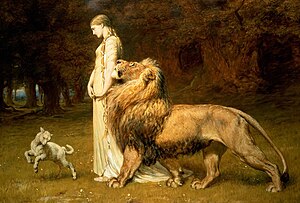
The lion is a popular sporting mascot or symbol, not only for sports but also businesses and other entities; Patience and Fortitude, are the large stone lions outside the main branch of the New York Public Library, and are the mascots of the New York and Brooklyn Public Library system. A modified heraldic lion is the emblem of Australian car company Holden, an iconic Australian brand.[40]
The Flag of Iran bore the Lion and Sun from 1946 to 1979.[41]
In Brazil, the lion is a popular symbol of the income tax.
At the 1966 FIFA World Cup and the 2006 FIFA World Cup, both contained lions as their mascot
Some Ford Motor Company motor vehicles of the 1960s and 1970s featured a lion as part of the car emblem e.g. the Ford Torino, Ford LTD, Mercury Marquis, and Ford XL.
Turkish major football club Galatasaray SK is symbolized by a lion since 1930s among Turkish media, and fans.
See also
- Lion-baiting
- Winged lion
- Piraeus Lion
- Manticore (mythical part-lion beast)
- Khoekhoe Lion Story
References
- ^ Packer, Craig; Clottes, Jean (November 2000). "When Lions Ruled France" (PDF). Natural History: 52–57. Retrieved 27 August 2007.
- ^ Züchner, Christian (September 1998). Grotte Chauvet Archaeologically Dated. International Rock Art Congress IRAC ´98 - Vila Real – Portugal. Retrieved 27 August 2007.
{{cite conference}}: CS1 maint: location (link) - ^ a b c d Garai, Jana (1973). The Book of Symbols. New York: Simon & Schuster. ISBN 978-0-671-21773-0.
- ^ Cassin, Elena (1981). "Le roi et le lion" (PDF). Revue de l'histoire des religions. 298 (198–4): 355–401. doi:10.3406/rhr.1981.4828. Retrieved 3 December 2009.
- ^ "The Art Institute of Chicago". The Chicago Traveller. 2007
- ^ a b "The Hidden Language of Anatolia". Skylife Magazine, 2001
- ^ "Iraqi Multi-National Force & Corps Logos, Ancient Assyro-Babylonian Images". Zinda Magazine, 2004.
- ^ Matthews, Kevin (2007). Lion Gate. Great Buildings Online.
- ^ http://www.visual-arts-cork.com/ancient-art/persian.htm
- ^ Graves, R (1955). "The First Labour:The Nemean Lion". Greek Myths. London: Penguin. pp. 465–469. ISBN 0-14-001026-2.
- ^ "Plato, Republic 588A-589B". "The Gnostic Society Library. Retrieved 12 February 2009.
- ^ C.A.W. Guggisberg, Simba
- ^ Wikisource:Bible (American Standard)/1 Peter#Chapter 5 Verse 8
- ^ Epstein, Marc Michael (1997). Dreams of subversion in medieval Jewish art and literature. Penn State Press. pp. 110, 121. ISBN 0-271-01605-1. Retrieved 13 September 2010.
- ^ JPS Tanakh
- ^ Hipp. Ref. vi. 9
- ^ Apocryphon of John
- ^ von Gall, Hubertus, "The Lion-headed and the Human-headed God in the Mithraic Mysteries," in Jacques Duchesne-Guillemin ed. Études mithriaques, 1978, pp. 511
- ^ Jackson, Howard M., "The Meaning and Function of the Leontocephaline in Roman Mithraism" in Numen, Vol. 32, Fasc. 1 (Jul., 1985), pp. 17-45
- ^ David M Gwynn (2010). Religious diversity in late antiquity. BRILL. p. 448.
- ^ Beck, R, Beck on Mithraism, pp. 194
- ^ [1]
- ^ Dr. McCleod, Head of Sikh Studies, Department of South Asian Studies, McMaster University, Hamilton, Ontario, Canada
- ^ Khushwant Singh, A History of the Sikhs, Volume I
- ^ A History of the Sikh People (1469–1988) by Dr. Gopal Singh ISBN 81-7023-139-6
- ^ "Singapore". bartleby.com. Retrieved 14 April 2006.
- ^ "Early History". Ministry of Information, Communications and the Arts, Singapore. Retrieved 14 April 2006.
- ^ http://www.tribuneindia.com/2002/20021006/spectrum/art.htm
- ^ Seale, Patrick (1990). Asad: The Struggle for the Middle East. University of California Press. p. 25. ISBN 9780520069763.
- ^ a b "History Behind Lion Statues House of Cards Opening Credits". Ghosts of DC. 20 February 2014.
{{cite web}}: Unknown parameter|authors=ignored (help) - ^ "Bronze Lions Flank Connecticut Avenue Entrance". National Zoo.
- ^ Wade, W. Cecil (1898). Symbolisms of Heraldry. London: Kessinger Publishing. p. 168. ISBN 978-0-7661-4168-1.
- ^ "Heraldic Dictionary:Beasts". University of Notre Dame. Retrieved 20 July 2007.
- ^ a b Dunkling L, Wright G (1994) [1987]. The Wordsworth Dictionary of Pub Names. Ware, Hertfordshire: Wordsworth Reference. ISBN 1-85326-334-6.
- ^ L. Frank Baum, Michael Patrick Hearn, The Annotated Wizard of Oz, p 148, ISBN 0-517-50086-8
- ^ Lewis, C.S. (1950). The Lion, the Witch and the Wardrobe. HarperCollins. ISBN 0-06-023481-4.
- ^ "TV ACRES: Advertising Mascots - Animals - Leo the MGM Lion (MGM Studios)". TV Acres.
- ^ The Ghost and the Darkness Were Their Names on Flickr - Photo Sharing!
- ^ Heart of a Lioness
- ^ Superbrands:An Insight into more than 80 of Australia's Superbrands - Volume II. Sydney: Stephen P. Smith. 1999. ISBN 0-9577000-0-8.
- ^ Shahbazi, A. Shapur (2001). "Flags". Encyclopedia Iranica. Vol. 10. Costa Mesa: Mazda.










